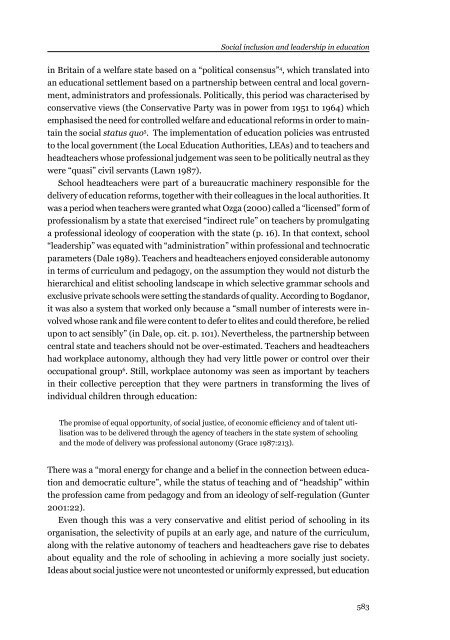Social inclusion and leadership in education: An evolution of roles ...
Social inclusion and leadership in education: An evolution of roles ...
Social inclusion and leadership in education: An evolution of roles ...
- No tags were found...
You also want an ePaper? Increase the reach of your titles
YUMPU automatically turns print PDFs into web optimized ePapers that Google loves.
<strong>Social</strong> <strong><strong>in</strong>clusion</strong> <strong>and</strong> <strong>leadership</strong> <strong>in</strong> <strong>education</strong><strong>in</strong> Brita<strong>in</strong> <strong>of</strong> a welfare state based on a “political consensus” 4 , which translated <strong>in</strong>toan <strong>education</strong>al settlement based on a partnership between central <strong>and</strong> local government,adm<strong>in</strong>istrators <strong>and</strong> pr<strong>of</strong>essionals. Politically, this period was characterised byconservative views (the Conservative Party was <strong>in</strong> power from 1951 to 1964) whichemphasised the need for controlled welfare <strong>and</strong> <strong>education</strong>al reforms <strong>in</strong> order to ma<strong>in</strong>ta<strong>in</strong>the social status quo 5 . The implementation <strong>of</strong> <strong>education</strong> policies was entrustedto the local government (the Local Education Authorities, LEAs) <strong>and</strong> to teachers <strong>and</strong>headteachers whose pr<strong>of</strong>essional judgement was seen to be politically neutral as theywere “quasi” civil servants (Lawn 1987).School headteachers were part <strong>of</strong> a bureaucratic mach<strong>in</strong>ery responsible for thedelivery <strong>of</strong> <strong>education</strong> reforms, together with their colleagues <strong>in</strong> the local authorities. Itwas a period when teachers were granted what Ozga (2000) called a “licensed” form <strong>of</strong>pr<strong>of</strong>essionalism by a state that exercised “<strong>in</strong>direct rule” on teachers by promulgat<strong>in</strong>ga pr<strong>of</strong>essional ideology <strong>of</strong> cooperation with the state (p. 16). In that context, school“<strong>leadership</strong>” was equated with “adm<strong>in</strong>istration” with<strong>in</strong> pr<strong>of</strong>essional <strong>and</strong> technocraticparameters (Dale 1989). Teachers <strong>and</strong> headteachers enjoyed considerable autonomy<strong>in</strong> terms <strong>of</strong> curriculum <strong>and</strong> pedagogy, on the assumption they would not disturb thehierarchical <strong>and</strong> elitist school<strong>in</strong>g l<strong>and</strong>scape <strong>in</strong> which selective grammar schools <strong>and</strong>exclusive private schools were sett<strong>in</strong>g the st<strong>and</strong>ards <strong>of</strong> quality. Accord<strong>in</strong>g to Bogdanor,it was also a system that worked only because a “small number <strong>of</strong> <strong>in</strong>terests were <strong>in</strong>volvedwhose rank <strong>and</strong> file were content to defer to elites <strong>and</strong> could therefore, be reliedupon to act sensibly” (<strong>in</strong> Dale, op. cit. p. 101). Nevertheless, the partnership betweencentral state <strong>and</strong> teachers should not be over-estimated. Teachers <strong>and</strong> headteachershad workplace autonomy, although they had very little power or control over theiroccupational group 6 . Still, workplace autonomy was seen as important by teachers<strong>in</strong> their collective perception that they were partners <strong>in</strong> transform<strong>in</strong>g the lives <strong>of</strong><strong>in</strong>dividual children through <strong>education</strong>:The promise <strong>of</strong> equal opportunity, <strong>of</strong> social justice, <strong>of</strong> economic efficiency <strong>and</strong> <strong>of</strong> talent utilisationwas to be delivered through the agency <strong>of</strong> teachers <strong>in</strong> the state system <strong>of</strong> school<strong>in</strong>g<strong>and</strong> the mode <strong>of</strong> delivery was pr<strong>of</strong>essional autonomy (Grace 1987:213).There was a “moral energy for change <strong>and</strong> a belief <strong>in</strong> the connection between <strong>education</strong><strong>and</strong> democratic culture”, while the status <strong>of</strong> teach<strong>in</strong>g <strong>and</strong> <strong>of</strong> “headship” with<strong>in</strong>the pr<strong>of</strong>ession came from pedagogy <strong>and</strong> from an ideology <strong>of</strong> self-regulation (Gunter2001:22).Even though this was a very conservative <strong>and</strong> elitist period <strong>of</strong> school<strong>in</strong>g <strong>in</strong> itsorganisation, the selectivity <strong>of</strong> pupils at an early age, <strong>and</strong> nature <strong>of</strong> the curriculum,along with the relative autonomy <strong>of</strong> teachers <strong>and</strong> headteachers gave rise to debatesabout equality <strong>and</strong> the role <strong>of</strong> school<strong>in</strong>g <strong>in</strong> achiev<strong>in</strong>g a more socially just society.Ideas about social justice were not uncontested or uniformly expressed, but <strong>education</strong>583

















